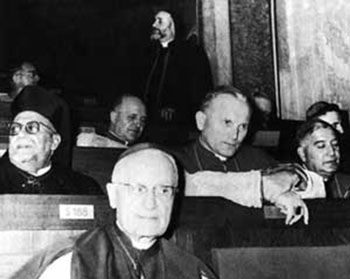Asuntos Tradicionalistas
 |
 |
 |
 |
 |
 |
 |
Misa de Diálogo - CXIV
Dando a los Laicos la Ilusión de Poder
La evidencia que hemos revisado hasta ahora muestra que la supresión de las Órdenes Menores en 1972 surgió del deseo revolucionario de subvertir la Constitución de la Iglesia, cambiándola de una estructura monárquica de dos niveles de gobernantes y gobernados a un arreglo menos rígido, uno en el que se daría a los laicos, al menos la ilusión de poder en todos los aspectos de la vida eclesiástica.
 Ahora está claro que esta revolución fue planeada durante las sesiones del Concilio Vaticano II donde ciertos obispos, motivados tanto por la ideología como por un deseo de control clericalista, jugaron un papel crucial en el sabotaje del Concilio. Lograron su objetivo plantando primero ideas progresistas en los documentos del Concilio. Luego, habiendo ascendido a posiciones prominentes en la Iglesia, usaron su influencia para guiar a los fieles por el camino preestablecido de reforma.
Ahora está claro que esta revolución fue planeada durante las sesiones del Concilio Vaticano II donde ciertos obispos, motivados tanto por la ideología como por un deseo de control clericalista, jugaron un papel crucial en el sabotaje del Concilio. Lograron su objetivo plantando primero ideas progresistas en los documentos del Concilio. Luego, habiendo ascendido a posiciones prominentes en la Iglesia, usaron su influencia para guiar a los fieles por el camino preestablecido de reforma.
Un ejemplo notorio fue el obispo Karol Wojtyla, el futuro Papa Juan Pablo II, quien fue uno de varios obispos involucrados en la redacción del borrador de la Constitución de la Iglesia, Lumen gentium.
Es importante saber que el propósito de sus esfuerzos fue producir un nuevo texto sobre la Iglesia como sustituto del esquema original sobre la Constitución de la Iglesia De Ecclesia, que había sido redactado por obispos tradicionalistas. bajo la presidencia del Card. Ottaviani, jefe de la Comisión Teológica.
El "guerrero despertó" temprano
Las intervenciones del obispo Wojtyla en los debates, registradas en las Acta Synodalia, muestran que el esquema le parecía inaceptable porque trataba el tema de la santidad en la Iglesia casi exclusivamente con referencia al clero y a los religiosos, sin apenas palabra sobre los fieles ordinarios. (1) En otras palabras, contenía, en su opinión, un sesgo implícito contra los laicos.
Pero esta crítica era en sí misma injusta porque no promovía el debido respeto al sacerdocio y a la vida religiosa como vocación superior a la santidad. En cambio, atacó al hombre de paja de la "falta de respeto" por los laicos, que creía que se expresaba en el hecho de que algunas personas, el clero y los religiosos, son señaladas por un estado de santidad más alto que otras.
La única vía, a su juicio, para restablecer el equilibrio era insistir en que los tres Consejos evangélicos de perfección, que son objeto de los votos religiosos en la vida consagrada, no debían ser exclusivos de ellos, sino que debían ser ejercidos también por los laicos. en su vida diaria. Esto es lo que él llamó “la llamada universal a la santidad” (vocatio universalis ad sanctitatem). Dijo:
 “Sin embargo, por otro lado, también es importante que la llamada a la santidad no se limite; que todos sepan que se les ofrece y es verdaderamente posible para ellos. Por tanto, el Concilio debe exhortar a todos, no sólo a los que tienen el cuidado de las almas, sino también a los laicos, a buscar caminos y métodos de santidad también en el mundo y hacerlos visibles a los demás, para que junto a la ascesis monástica haya una ascesis mundana,para hacerlo evolucionar, por así decirlo”. (2)
“Sin embargo, por otro lado, también es importante que la llamada a la santidad no se limite; que todos sepan que se les ofrece y es verdaderamente posible para ellos. Por tanto, el Concilio debe exhortar a todos, no sólo a los que tienen el cuidado de las almas, sino también a los laicos, a buscar caminos y métodos de santidad también en el mundo y hacerlos visibles a los demás, para que junto a la ascesis monástica haya una ascesis mundana,para hacerlo evolucionar, por así decirlo”. (2)
Este pasaje contenía una acusación sutil de que la Iglesia anterior al Vaticano II había limitado la adquisición de la santidad a aquellos en la vida clerical o religiosa y había descuidado la de los laicos. Esta afirmación no solo era demostrablemente falsa y una distorsión de la realidad, ya que la Iglesia nunca ha dejado de proporcionar los medios de santidad a través del ministerio del clero para todos los laicos, sino que también tenía el potencial de generar conflicto y rivalidad entre el clero y los laicos.
Quienes continúan haciendo esta acusación ignoran el hecho de que la Iglesia siempre ha mantenido una distinción entre los Preceptos del Evangelio que obligan a todos los cristianos, y los Consejos evangélicos de perfección que son la vocación de relativamente pocos. Esta distinción, dicho sea de paso, también fue negada por los herejes en todas las épocas, pero particularmente por los protestantes en el siglo XVI.
Una ruptura intencional con el pasado
Esto fue más evidente en el deseo de Wojtyla de colocar lo que siempre había sido reconocido como el estado de santidad superior de la vida clerical, monástica o religiosa a la par con los medios de santificación ordinarios a disposición de los laicos que viven en el mundo.
El remedio que propuso, fue que todos, no solo las personas consagradas, deben seguir los consejos evangélicos, y fue problemático por varias razones.
Primero, los Consejos no eran mandatos de obligación universal, y no incumbían a los laicos que vivían en sociedad. Por el contrario, las practicaban aquellos que habían dejado atrás el mundo para dedicar su vida por completo a Dios. Como tales, se entendían como una búsqueda más eficaz de la santidad porque proporcionaban los medios para que aquellos que libremente habían hecho votos públicos en una profesión religiosa alcanzaran un estado superior de santidad a través de una vivencia más intensa del Evangelio.
Esto está en línea con las palabras de Nuestro Señor al joven rico. (Mat. 19: 16-21) (3) Se sigue que la vida religiosa, ya sea de sacerdotes, monjes o monjas, es objetivamente más santa que la vida cristiana común.
Segundo, usar los Consejos como base para la santidad universal no es ni realista ni honesto. La Iglesia nunca ha adoptado este enfoque, ni los Evangelios lo han requerido. Su efecto fue disminuir el valor de la vocación religiosa como único testimonio de las realidades trascendentes que están más allá de este mundo, poniéndola al mismo nivel que las tareas de este mundo.
Tal es la confusión engendrada por el “llamado universal a la santidad” que la misma palabra “vocación”, que antes se aplicaba en sentido estricto a la vida consagrada, ahora es utilizada por los líderes de la Iglesia para abarcar el estado matrimonial. En consecuencia, “orar por las vocaciones” incluye el Matrimonio en un nivel de igualdad con el estado superior del Celibato Sacerdotal y la Virginidad Consagrada.
Tercero, la expresión ascesis mundana (ascetismo mundano) es confusa, por decir lo menos, porque los Consejos Evangélicos estaban destinados a liberar el alma de las preocupaciones mundanas. La misma palabra mundana delata su incongruencia con la enseñanza católica tradicional sobre la santidad porque, en el lenguaje de la Iglesia, mundus (el mundo) casi siempre se oponía a caelum (cielo) como uno de los enemigos del alma.
 La expresión es una completa novedad porque el mundo, el reino del pecado y la muerte, de ninguna manera podría promover el Reino de santidad y vida de Cristo. Nunca ha sido parte de la visión católica de la santidad, que es enteramente sobrenatural y consiste en hacer penitencia por los propios pecados por amor a Dios y dolor por haber ofendido su bondad. Por lo tanto, es diferente en esencia de cualquier ascetismo realizado en un nivel puramente natural o “mundano”.
La expresión es una completa novedad porque el mundo, el reino del pecado y la muerte, de ninguna manera podría promover el Reino de santidad y vida de Cristo. Nunca ha sido parte de la visión católica de la santidad, que es enteramente sobrenatural y consiste en hacer penitencia por los propios pecados por amor a Dios y dolor por haber ofendido su bondad. Por lo tanto, es diferente en esencia de cualquier ascetismo realizado en un nivel puramente natural o “mundano”.
Esta frase autocontradictoria debe verse a la luz de la Nouvelle Théologie adoptada por el Vaticano II que, bajo la influencia de teólogos como Rahner, de Lubac y Schillebeeckx, derrumbó el dualismo espiritual entre lo sobrenatural y lo natural, lo divino y lo meramente humano, la Iglesia y el Mundo, haciendo difícil discernir la distinción entre las dos categorías.
Antes del Vaticano II, se entendía claramente que los hombres y las mujeres entraban en la vida religiosa con un fin sobrenatural, explícitamente la salvación de sus almas, incluso si algunos realizaban servicios de enseñanza, enfermería, etc. en el mundo exterior. Pero la Nouvelle Théologie hizo de la Iglesia en general y de la vida religiosa en particular el objetivo del servicio del hombre y no principalmente el servicio de Dios. Esto llevó al olvido moderno de que a Dios se le sirve primero.
Declive terminal de las órdenes religiosas
Por definición, tal teorización radical, que invierte la enseñanza de la Iglesia, estaba destinada a socavar la Tradición e inevitablemente tendría un efecto destructivo en las vocaciones al sacerdocio y la vida religiosa.
Porque la distinción tradicional entre la Iglesia y el Mundo era el elemento central de las Congregaciones Religiosas y un factor significativo para atraer y sostener vocaciones. Proporcionó un terreno fértil para las vocaciones de los fieles que buscaban alcanzar un mayor grado de santidad precisamente apartándose del mundo y sus caminos. Esto era exactamente lo que decía el esquema original De Ecclesia, que fue rechazado por los obispos progresistas en el Concilio. (4)
 La novedosa enseñanza insertada en la Lumen gentium del obispo Wojtyla de que todas las personas están llamadas exactamente a la misma santidad (ad ipsam sanctitatem vocantur), (5) ya sea en el presbiterio, el claustro o el mundo exterior, eliminaba efectivamente el principal incentivo para acceder al sacerdocio oa la vida religiosa.
La novedosa enseñanza insertada en la Lumen gentium del obispo Wojtyla de que todas las personas están llamadas exactamente a la misma santidad (ad ipsam sanctitatem vocantur), (5) ya sea en el presbiterio, el claustro o el mundo exterior, eliminaba efectivamente el principal incentivo para acceder al sacerdocio oa la vida religiosa.
El resultado de crear este quimérico compuesto Iglesia-Mundo consagrado en el lema “igualdad de santidad para todos” fue inducir un declive terminal en las vocaciones religiosas. No es de extrañar que tantos seminarios, conventos y monasterios hoy no hayan logrado atraer nuevas vocaciones y estén muriendo.
Todo es parte de un proceso de desacralización, adoctrinando a los sacerdotes y religiosos para que vean su objetivo principal en esta vida como laico y humanitario, transformándolos en trabajadores sociales que ayuden a los laicos a mejorar las condiciones de vida en este mundo, en lugar de prepararlos para el siguiente.
Continuará ...

Wojtyla en el Concilio
Un ejemplo notorio fue el obispo Karol Wojtyla, el futuro Papa Juan Pablo II, quien fue uno de varios obispos involucrados en la redacción del borrador de la Constitución de la Iglesia, Lumen gentium.
Es importante saber que el propósito de sus esfuerzos fue producir un nuevo texto sobre la Iglesia como sustituto del esquema original sobre la Constitución de la Iglesia De Ecclesia, que había sido redactado por obispos tradicionalistas. bajo la presidencia del Card. Ottaviani, jefe de la Comisión Teológica.
El "guerrero despertó" temprano
Las intervenciones del obispo Wojtyla en los debates, registradas en las Acta Synodalia, muestran que el esquema le parecía inaceptable porque trataba el tema de la santidad en la Iglesia casi exclusivamente con referencia al clero y a los religiosos, sin apenas palabra sobre los fieles ordinarios. (1) En otras palabras, contenía, en su opinión, un sesgo implícito contra los laicos.
Pero esta crítica era en sí misma injusta porque no promovía el debido respeto al sacerdocio y a la vida religiosa como vocación superior a la santidad. En cambio, atacó al hombre de paja de la "falta de respeto" por los laicos, que creía que se expresaba en el hecho de que algunas personas, el clero y los religiosos, son señaladas por un estado de santidad más alto que otras.
La única vía, a su juicio, para restablecer el equilibrio era insistir en que los tres Consejos evangélicos de perfección, que son objeto de los votos religiosos en la vida consagrada, no debían ser exclusivos de ellos, sino que debían ser ejercidos también por los laicos. en su vida diaria. Esto es lo que él llamó “la llamada universal a la santidad” (vocatio universalis ad sanctitatem). Dijo:

El Vaticano II pretendía poner el matrimonio
al mismo nivel que el sacerdocio
Este pasaje contenía una acusación sutil de que la Iglesia anterior al Vaticano II había limitado la adquisición de la santidad a aquellos en la vida clerical o religiosa y había descuidado la de los laicos. Esta afirmación no solo era demostrablemente falsa y una distorsión de la realidad, ya que la Iglesia nunca ha dejado de proporcionar los medios de santidad a través del ministerio del clero para todos los laicos, sino que también tenía el potencial de generar conflicto y rivalidad entre el clero y los laicos.
Quienes continúan haciendo esta acusación ignoran el hecho de que la Iglesia siempre ha mantenido una distinción entre los Preceptos del Evangelio que obligan a todos los cristianos, y los Consejos evangélicos de perfección que son la vocación de relativamente pocos. Esta distinción, dicho sea de paso, también fue negada por los herejes en todas las épocas, pero particularmente por los protestantes en el siglo XVI.
Una ruptura intencional con el pasado
Esto fue más evidente en el deseo de Wojtyla de colocar lo que siempre había sido reconocido como el estado de santidad superior de la vida clerical, monástica o religiosa a la par con los medios de santificación ordinarios a disposición de los laicos que viven en el mundo.
El remedio que propuso, fue que todos, no solo las personas consagradas, deben seguir los consejos evangélicos, y fue problemático por varias razones.
Primero, los Consejos no eran mandatos de obligación universal, y no incumbían a los laicos que vivían en sociedad. Por el contrario, las practicaban aquellos que habían dejado atrás el mundo para dedicar su vida por completo a Dios. Como tales, se entendían como una búsqueda más eficaz de la santidad porque proporcionaban los medios para que aquellos que libremente habían hecho votos públicos en una profesión religiosa alcanzaran un estado superior de santidad a través de una vivencia más intensa del Evangelio.
Esto está en línea con las palabras de Nuestro Señor al joven rico. (Mat. 19: 16-21) (3) Se sigue que la vida religiosa, ya sea de sacerdotes, monjes o monjas, es objetivamente más santa que la vida cristiana común.
Segundo, usar los Consejos como base para la santidad universal no es ni realista ni honesto. La Iglesia nunca ha adoptado este enfoque, ni los Evangelios lo han requerido. Su efecto fue disminuir el valor de la vocación religiosa como único testimonio de las realidades trascendentes que están más allá de este mundo, poniéndola al mismo nivel que las tareas de este mundo.
Tal es la confusión engendrada por el “llamado universal a la santidad” que la misma palabra “vocación”, que antes se aplicaba en sentido estricto a la vida consagrada, ahora es utilizada por los líderes de la Iglesia para abarcar el estado matrimonial. En consecuencia, “orar por las vocaciones” incluye el Matrimonio en un nivel de igualdad con el estado superior del Celibato Sacerdotal y la Virginidad Consagrada.
Tercero, la expresión ascesis mundana (ascetismo mundano) es confusa, por decir lo menos, porque los Consejos Evangélicos estaban destinados a liberar el alma de las preocupaciones mundanas. La misma palabra mundana delata su incongruencia con la enseñanza católica tradicional sobre la santidad porque, en el lenguaje de la Iglesia, mundus (el mundo) casi siempre se oponía a caelum (cielo) como uno de los enemigos del alma.

Un retrato posterior al Vaticano II de 'la llamada universal a la santidad'
Esta frase autocontradictoria debe verse a la luz de la Nouvelle Théologie adoptada por el Vaticano II que, bajo la influencia de teólogos como Rahner, de Lubac y Schillebeeckx, derrumbó el dualismo espiritual entre lo sobrenatural y lo natural, lo divino y lo meramente humano, la Iglesia y el Mundo, haciendo difícil discernir la distinción entre las dos categorías.
Antes del Vaticano II, se entendía claramente que los hombres y las mujeres entraban en la vida religiosa con un fin sobrenatural, explícitamente la salvación de sus almas, incluso si algunos realizaban servicios de enseñanza, enfermería, etc. en el mundo exterior. Pero la Nouvelle Théologie hizo de la Iglesia en general y de la vida religiosa en particular el objetivo del servicio del hombre y no principalmente el servicio de Dios. Esto llevó al olvido moderno de que a Dios se le sirve primero.
Declive terminal de las órdenes religiosas
Por definición, tal teorización radical, que invierte la enseñanza de la Iglesia, estaba destinada a socavar la Tradición e inevitablemente tendría un efecto destructivo en las vocaciones al sacerdocio y la vida religiosa.
Porque la distinción tradicional entre la Iglesia y el Mundo era el elemento central de las Congregaciones Religiosas y un factor significativo para atraer y sostener vocaciones. Proporcionó un terreno fértil para las vocaciones de los fieles que buscaban alcanzar un mayor grado de santidad precisamente apartándose del mundo y sus caminos. Esto era exactamente lo que decía el esquema original De Ecclesia, que fue rechazado por los obispos progresistas en el Concilio. (4)

Mujeres religiosas ancianas y poco inspiradoras se reúnen para discutir su sombrío futuro
El resultado de crear este quimérico compuesto Iglesia-Mundo consagrado en el lema “igualdad de santidad para todos” fue inducir un declive terminal en las vocaciones religiosas. No es de extrañar que tantos seminarios, conventos y monasterios hoy no hayan logrado atraer nuevas vocaciones y estén muriendo.
Todo es parte de un proceso de desacralización, adoctrinando a los sacerdotes y religiosos para que vean su objetivo principal en esta vida como laico y humanitario, transformándolos en trabajadores sociales que ayuden a los laicos a mejorar las condiciones de vida en este mundo, en lugar de prepararlos para el siguiente.
Continuará ...
- Acta Synodalia, Segunda Sesión, Parte 4, p. 341.
- Ibíd., p. 342.
- Pero en el primer capítulo de su Encíclica Veritatis splendor(1992), el Papa Juan Pablo II, ignorando la distinción entre los Consejos Evangélicos para los religiosos y los Preceptos de la vida moral para el resto de los fieles afirmaron: “Esta vocación al amor perfecto no se limita a un pequeño grupo de personas. La invitación, "ve, vende tus posesiones y da el dinero a los pobres", y la promesa "'tendrás tesoro en el cielo', son para todos". [Énfasis en el original]
- El capítulo 5 de este esquema explica que, por estar “los consejos evangélicos ligados necesariamente a la imitación de Cristo y librar eficazmente al alma de las preocupaciones seculares, atraen a su observancia, más que nadie, a los que desean expresar más claramente la vida del Salvador en sí mismos, ya sea por la oración o la contemplación, o por el trabajo apostólico, o por las obras de misericordia espirituales y corporales, o por la vida en común.
- Acta Synodalia, p. 341.
Publicado el 19 de abril de 2022
______________________
______________________
 Volume I |
 Volume II |
 Volume III |
 Volume IV |
 Volume V |
 Volume VI |
 Volume VII |
 Volume VIII |
 Volume IX |
 Volume X |
 Volume XI |
 Special Edition |



